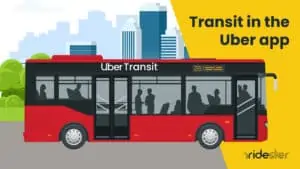When you need to get around town every day of the week — or even multiple times a day — the cost of gas can take a toll on your budget.
Luckily, your ideal transportation solution may be just a few clicks away.
Whether you need to save on your ride to work or your commute to school, vanpools are around to help.
Even in urban areas like New York City that have many modes of public transportation, the average driver will spend over $600 on gas each year.
Vanpools are a lesser known alternative to carpools, UberPool, and Lyft Shared that effectively save you money that rideshare apps don’t, while reducing the time you’d spend commuting with a bus service or subway.
This article will explain how vanpools work and how you can benefit.
What Is a Vanpool?

A vanpool can best be described as a blend between a traditional carpools and shared on-demand services like UberPool.
In comparison to carpools, vanpools tend to provide a more organized system and an easier way to connect with other people on your route.
Rather than a group of friends or coworkers sharing their private cars, a designated driver will be granted a vanpool vehicle to use for commuting purposes.
If people in your area want to join in, it can reduce your cost further.
Unlike on-demand services, you won’t have to request new ride daily and wait to be matched with a new driver and new co-riders each time.
You’ll have a set pick-up time that you can plan on scheduling your time around.
In addition, vanpoolers are usually charged a set weekly or monthly fee.
This means you will never have to worry about surge pricing, which can peak during rush hours, when you’ll likely be doing your commute each work day.
How Does a Vanpool Work?
Anyone can create a vanpool for their local community as long as there is a central vanpool program set up by your local metro system or a state department.
This central program is how you’ll receive a vehicle and insurance coverage for your group.
Some destination-specific programs may also be set up by your company or your university, and can only be used by students or employees.
To find your local program, you can simply search “vanpool” with your city name (ex: “vanpool Los Angeles”) and look out for pages from your government or transportation authority.
You can also ask your employer or college administration if they have a separate vanpool set up.
Depending on which organization is in charge of distributing the vehicles, the way vanpools work may differ.
However, the following are typical for many vanpool programs in the United States:
- You need to pay a set fee. Most programs have options starting at $50 per month, depending on how many riders you have. This fare will include all costs regarding the vehicle.
- The vanpool coordinator is responsible for the group. Whoever sets up their local vanpool usually becomes one of two primary drivers for the group. Though some programs allow you to rotate drivers between all riders, usually only designated drivers drive and take home the vehicle due to the fact that prior application or training is required. The coordinator usually becomes the leaseholder, as well.
- You need to meet a minimum number of riders to receive a van. Before you sign up to create a vanpool, you typically need commitment from five people for a seven-passenger van, or up to 12 people for a 15-passenger van.
- You can join a vanpool at any time. You don’t have to be one of the founding members of a vanpool or an invitee to be part of one. Most programs have a platform for you to browse through current vanpools and join or request to join one near you.
- You can be booted for being inactive. If you’re not paying your fares or not using the service in any way, you can be booted from your vanpool. This can affect your fellow participants’ monthly fees, so make sure to always communicate with your co-riders.
Benefits of Joining a Vanpool

Joining an existing vanpool is typically as simple as finding your local program and searching on the platform for riders who have similar pick-up and drop-off locations.
However, this easy process isn’t the only benefit of joining a vanpool.
Here are additional reasons why this transportation method can help you out:
- You save money. For a low monthly fare, you will no longer be paying for gas, tolls, car insurance, or parking passes as an individual. What you end up paying will be a fraction of your cost as a solo driver or as a Uber or Lyft rider, which could have totaled up to thousands of dollars annually. You can also stop worrying about car maintenance, as this will be taken care of by your program.
- You’ll receive a reliable service. Public transit is notoriously unreliable, particularly outside of metropolitan areas where buses and rail lines don’t run as frequently. The reliability of rideshare apps depends on how many drivers are on the road, and shared rides may add on the variable of how far your co-riders live from the route. Vanpools tend to arrive according to a schedule that you determine, with only a few minutes’ difference if there’s heavy traffic.
- You can beat the traffic with HOV lanes. If you live far from your destination and need to take the freeway, you’ll get the benefit of HOV lanes during rush hour, so you can complete your commute faster than you would alone.
- You can get tax benefits. In some states, you won’t have to pay any taxes on your ongoing vanpool fares, making your commutes tax-free. Other states have commuter subsidies for anyone who uses vanpools. If your employer supports vanpools, you may be able to get your fares completely or partially reimbursed.
- You’ll have company on your commute. While this is technically true of other shared ride alternatives, vanpools are a safe way to share your ride with the same people each time. This means that you can become familiar with your co-riders and comfortably share a ride with friends.
In addition to helping yourself, you’ll also be naturally helping the environment by ensuring only one vehicle is on the road instead of five, or even 15.
Vanpooling is a sustainable way to travel for anyone seeking to limit their carbon emissions.
Frequently Asked Questions

Saving your money and the environment starts with the simple step of starting or joining a vanpool in your area.
To help you better understand how vanpools work, here are our answers to some frequently asked questions:
1. Will my ride home be included in my vanpool?
In most programs, yes.
It is the responsibility to your vanpool participants to determine pick-up and drop-off times and locations, so if your schedules don’t fully match up, you may want to opt out of a ride home or find a different vanpool.
Some larger vanpool programs may offer an emergency ride home program in situations where you absolutely need to leave before your vanpool is scheduled to go.
2. Am I required to ride with the vanpool every single weekday?
Though this is an economically smart option if you’re commuting daily, you are not required to ride every day if the schedule doesn’t work for you.
The only exception is if you are a primary driver.
In this case, you may be required to ride at least half of all the scheduled vanpool days to ensure every participant can receive a reliable ride.
3. How are vanpool costs determined?
While some programs charge every rider the same monthly fee, it’s common for programs to charge each unique vanpool a set monthly fee based on a few variables.
These variables may include how many riders are signed up for the vanpool, how many miles you expect to travel with your mapped out trips, and how many days per week the van will be used.
Join in on the Easier Way to Commute Together
When organizing a carpool group gets too difficult and driving alone or using rideshare apps gets too expensive, vanpools are available to help.
It’s a cost-effective transportation solution that many commuters don’t even realize exists.
We hope this guide has helped you explore this shared opportunity and learn how to set up or join a vanpool in your area.
Want to stick with rideshare apps, but get an alternative to Uber and Lyft?
Learn how to Via rideshare app can help you share rides for less.






